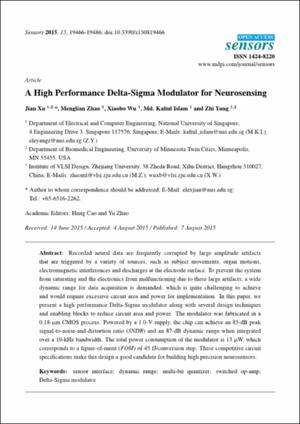A High Performance Delta-Sigma Modulator for Neurosensing

View/
Date
2015-08-07Author
Jian, Xu
Zhao, Menglian
Wu, Xiaobo
Islam, Md Kafiul
Yang, Zhi
Metadata
Show full item recordAbstract
Recorded neural data are frequently corrupted by large amplitude artifacts that are triggered by a variety of sources, such as subject movements, organ motions, electromagnetic interferences and discharges at the electrode surface. To prevent the system from saturating and the electronics from malfunctioning due to these large artifacts, a wide dynamic range for data acquisition is demanded, which is quite challenging to achieve and would require excessive circuit area and power for implementation. In this paper, we present a high performance Delta-Sigma modulator along with several design techniques and enabling blocks to reduce circuit area and power. The modulator was fabricated in a 0.18-μm CMOS process. Powered by a 1.0-V supply, the chip can achieve an 85-dB peak signal-to-noise-and-distortion ratio (SNDR) and an 87-dB dynamic range when integrated over a 10-kHz bandwidth. The total power consumption of the modulator is 13 μW, which corresponds to a figure-of-merit (FOM) of 45 fJ/conversion step. These competitive circuit specifications make this design a good candidate for building high precision neurosensors.
Collections
- Article [31]